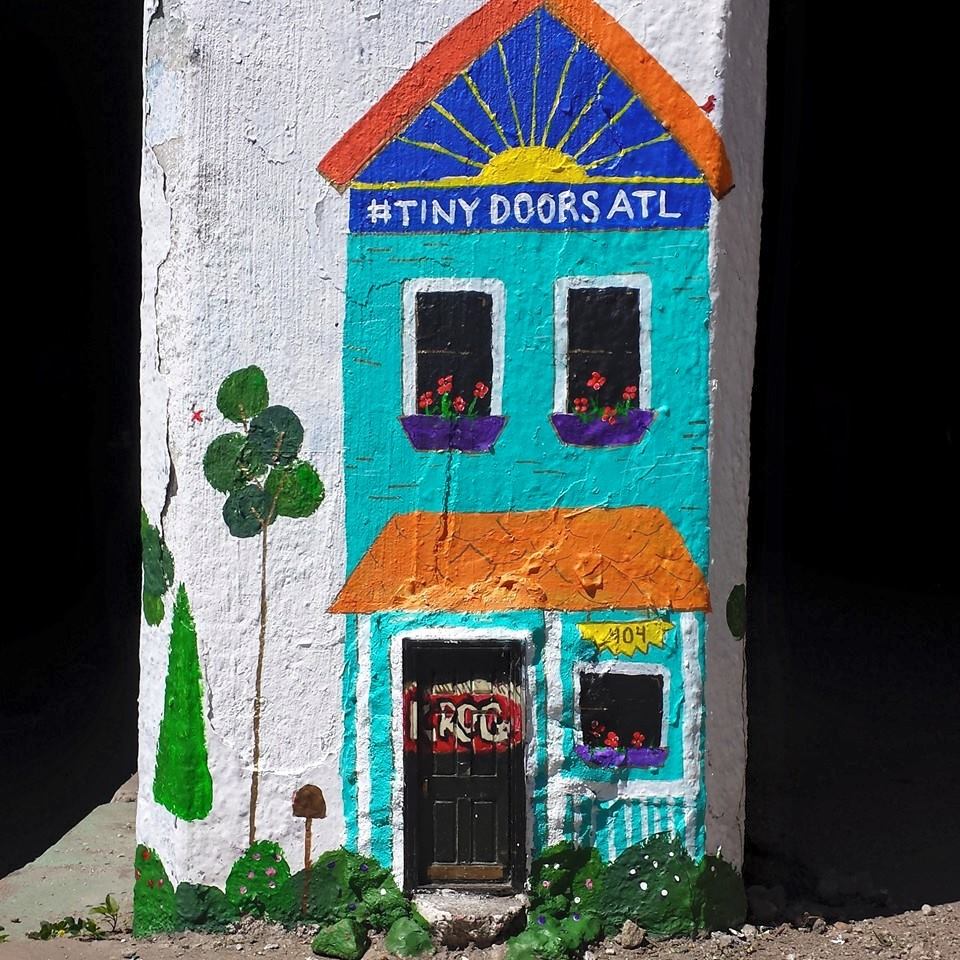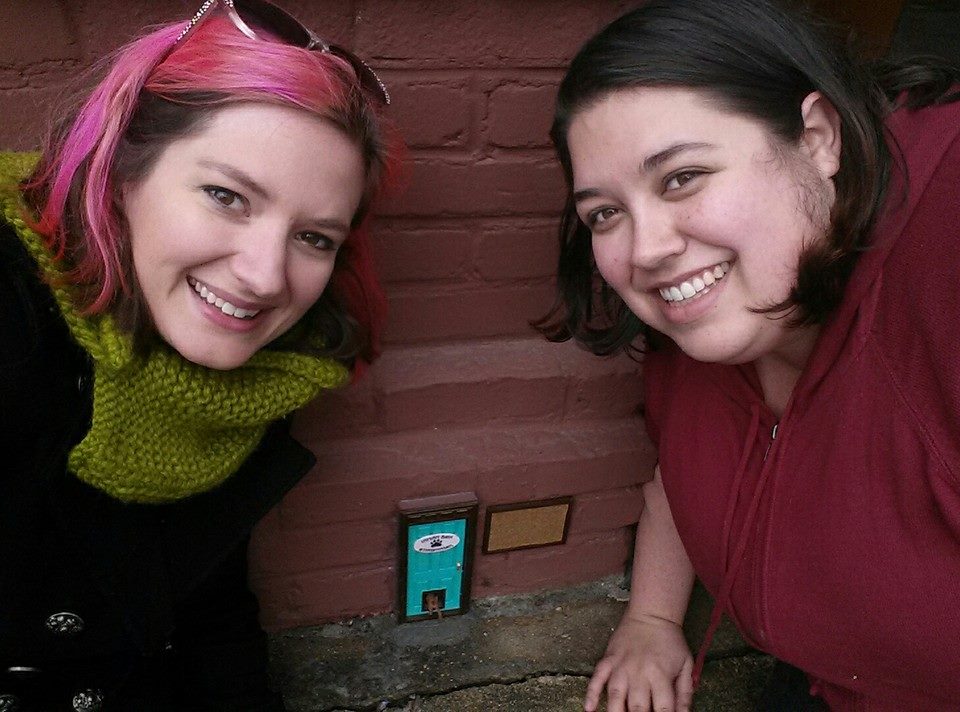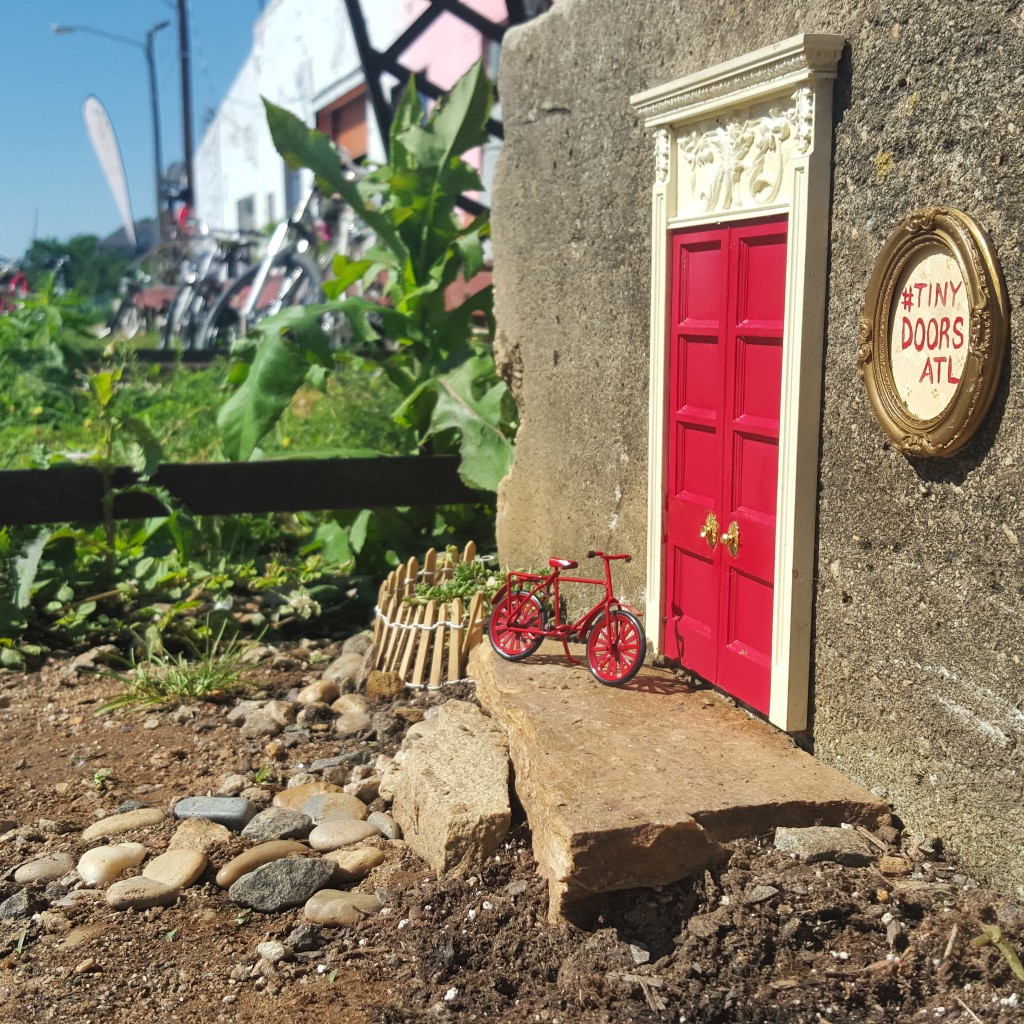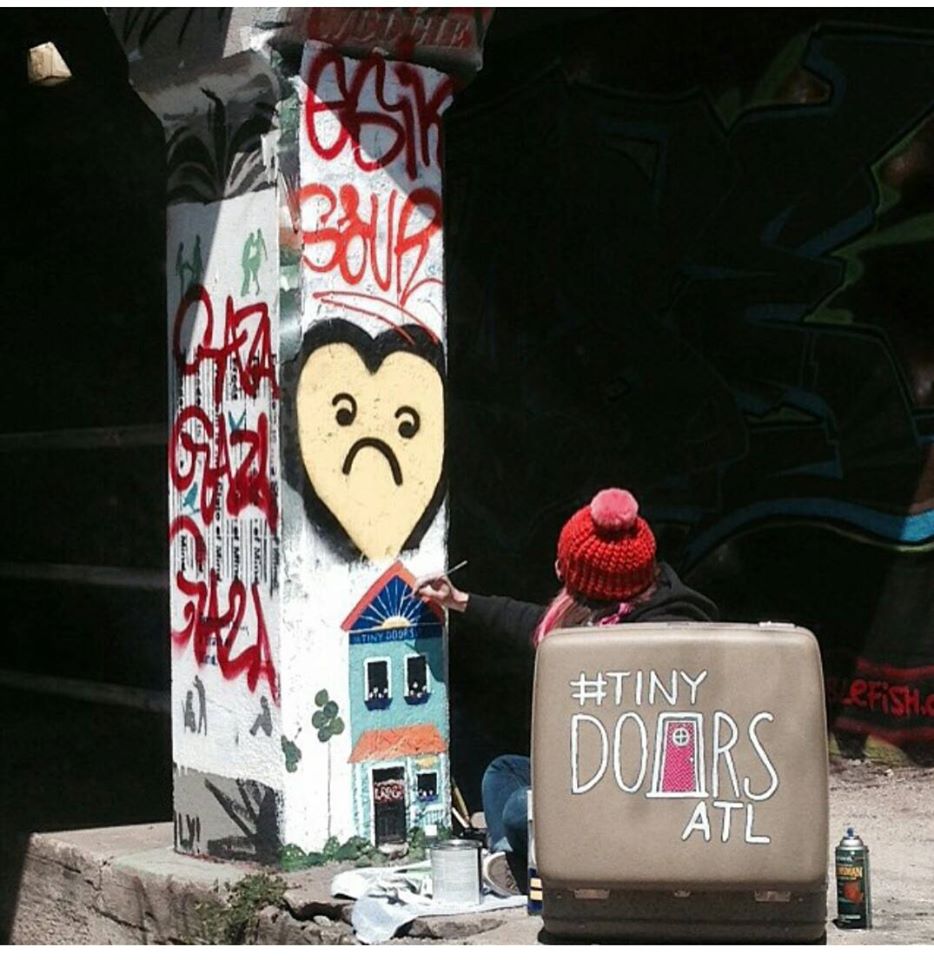The first time I spotted a Tiny Door was on the Atlanta BeltLine. I spied the small bright-pink door at the Old Fourth Skatepark. This door, #2, is by far my favorite—maybe because it’s decorated with small mirrors and disco gold border. It has so much pizzazz, it’s hard to ignore.
A small artist cooperative, Tiny Doors ATL‘s goal is to bring “big wonder to tiny spaces.” As a way to spread free public art around Atlanta, co-founders Karen Anderson and Atlanta-native Sarah Meng began installing 6-inch doors in unexpected places, the first one of those by Krog Street Tunnel last summer. The tiny doors, seven all together now, can be found in inconspicuous places like tree trunks, pet stores and bookstores. Every door is inaugurated by Rosie, a fearless (plastic toy) leader who presents the doors to the public during a ribbon cutting ceremony. You can easily miss the small doors, but they instantly make you smile if you spot them.
Now, the tiny but mighty organization is gearing up for a big campaign, more tiny doors, artist collaborations and Art on the BeltLine this September. We talked to Karen Anderson, about fairies, the process behind building a tiny door and Atlanta’s creative community.
CommonCreativ: How did you end up in Atlanta?
Karen Anderson: I’m originally from Ann Arbor, Michigan, where I went to an arts-focused public high school (we couldn’t wear shoes in the gym because the dance teacher got upset). After high school I played bass in a touring jazz/punk band for five years, then ended up going to art school at Rutgers University in New Jersey. I came to volunteer at Girls Rock Camp ATL while living in Jersey and decided to move to Atlanta after graduation. I feel at home here, and I can’t imagine living anywhere else. My partner and I live in a loft in Reynoldstown with a sweet dog and a giant cat.
CC: Have you always been in a creative field?
KA: I’ve been in a creative field my whole life. I began teaching art at a summer camp at 16, and have been leading workshops and classes and creating my own art since then. Right now I’m the volunteer Applied Arts Director for Girls Rock Camp ATL, I make sculptural custom cakes, and I’m the director of Tiny Doors ATL.
CC: How did Tiny Doors ATL start?
KA: After spending a year living, working and volunteering in Atlanta, I knew that I wanted to start a public art project, and I had a hunch that tiny doors might spark interest in the community. I also knew that it would be way more fun to do with a great team of people, so I asked a few friends to get involved, including mental health counselor and master crafter Sarah Meng. We installed the first door together, and she and I have formed a close partnership working on the project. We’re both dedicated to keeping the project going.
CC: What was the inspiration behind building small doors? They make me think of fairies or other magical beings.
KA: Ann Arbor boasts a large “fairy door” population. I wanted to bring a project to my new town with a similarly whimsical feel, being careful that it was a reflection of the Atlanta as a city. In order to do that, we took away the fairy element and centered the project around the viewer’s imagination. There’s so much thought-provoking art in Atlanta that people seem to easily catch on to the purpose behind this project without much explanation. We hear from people of all ages about who they think resides behind the doors, and every one is a little bit different.
CC: How do you choose the themes and locations for the Tiny Doors?
KA: All of our locations are public, all ages, and free to visit. We’re also focused on creating a walkable route for visitors, so we install new doors within walkable distance from an existing door whenever possible. Once a location has been established, we start planning the door. How will the door reflect its environment? What would help it to interact with the neighborhood? Who would live there, and how can the door feel accessible to everyone? We also think about the weather and foot traffic. If I broke it down, I’d say that the majority of time spent on the creation of the door is in the initial planning phase. Locations have a way of emerging through emails and interactions with the community. Our preference is to wait until an organization comes to us. We’ve met some great people this way!
CC: Where are the Tiny Doors built?
KA: The doors are made in at least two places. For such tiny pieces, they go through quite a few steps before you’ll see them installed publicly. First I work from home creating a mockup of the door we’re envisioning for the space. Then, if we need additional pieces, Sarah and I go visit a tiny carpenter OTP who has the very small tools and workshop to cut custom pieces based on our specs. From there, the door goes to the mold maker who creates silicone molds, then casts the door in the materials we need for the space. The door comes back to my house where we add paint, hardware, and anything else it needs before weatherproofing and finally installing.
CC: What materials do you all like using?
KA: Sarah and I often say we could write a book on adhesives. We start with wood and glue but end up with a resin cast product that we adhere using an obscene array of adhesives until we find exactly the right one for the job. We both have a special love for all things sparkly, which you can especially see reflected in Door #2 by the O4W Skatepark Door on the BeltLine.
CC: What do you hope Tiny Doors will do for Atlanta’s creative community?
KA: Much of what I’d hoped to see from this project is happening organically. For instance, I’d hoped that our doors would be tiny gathering places, landmarks for people to leave free art for #FAFATL, take creative photos, and get to know other areas of town by encouraging exploration to new neighborhoods. My big goals for the project include tying together communities, and eventually creating a full-time position with Tiny Doors ATL so that I can do the outreach to schools and camps that we’re being asked to provide. I’m also doing some consulting with other cities on their tiny public art movements.
CC: Many of the doors have been vandalized or destroyed. How do you all cope with that?
KA: The best and hardest thing about public art is that it’s in public. The vandalism we’ve experienced has been relatively rare considering how highly trafficked the areas are and the fragile nature of the doors. When it has happened I grieve for a minute for all of the time and creative energy that went into the door, then remind myself that the response has been overwhelmingly positive, and that the next door will be improved.
We’ve heard from people in the neighborhoods while we’re out working, and most people feel a sense of guardianship over the doors they see frequently. We have even been stopped ourselves by people asking who we were and why we were messing with the doors! The destruction of our most highly-trafficked door near the O4W skatepark in on the BeltLine in June prompted us to ask for donations to create a replacement door. We were humbled by the quick response of the community, and used the funds to hire a local artist to help us create stronger doors from our own designs.
CC: Do you have any dream collaborations with local artists?
KA: Our dream collaborations are with people who love what they do and who are contributing to the city in some way. After a collaboration meeting last night, we talked about the force of creative talent that is thriving in Atlanta. We started with the dream of joining the conversation between artists in Atlanta, namely at the Krog Street tunnel. Recently, talented chalk artist Katie Bush made a zine of our doors for Atlanta Zine Fest, and in September we have a collaborative installation with #weloveatl for Art on the Atlanta BeltLine.
CC: What’s next for Tiny Doors ATL?
KA: We do like to operate with a certain about of mystery. That said, I can tell you that we have a really exciting campaign coming up in September where we’re asking all of Atlanta to get involved! The resulting project will be installed in Cabbagetown in December.
Wondering where you can see a Tiny Door in the city? Check out their site for door locations and follow them on Instagram for updates.











